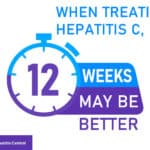Shortened Hepatitis C Treatment Increases Relapse Rate
Longer Hepatitis C Treatment Best?
Cure Rates Are Higher With Longer Treatment Of 6 Months, Research Suggests
July 11, 2007
www.cbsnews.com
(WebMD) Shortening treatment to less than six months does not appear to be a good strategy for patients with the most curable types of hepatitis C virus infection, new research suggests.
Patients with hepatitis C genotypes 2 and 3 who were treated for four months had lower cure rates and higher relapse rates than those treated for six months.
The study, which appears in Thursday’s New England Journal of Medicine, shows that longer treatment benefits even those with highly treatable hepatitis C, researcher Mitchell L. Shiffman, MD, tells WebMD.
“I tell patients if they can tolerate treatment and can stay on it for 24 weeks, they have a better chance of achieving the best possible outcome, which is a cure,” he says.
Hepatitis C Treatment Strategies
Long-term infection with hepatitis C virus (HCV) is a leading cause of cirrhosis, liver cancer, and liver transplants in the United States. As many as 4 million Americans are infected, but most don’t know it, experts say.
About 70 percent of infected Americans carry the genotype 1 form of hepatitis C, which tends to be less responsive to treatment than genotypes 2 and 3.
With aggressive treatment, nearly 80 percent of people with genotypes 2 or 3 achieve complete and sustained viral eradication, or cures, compared with about 40 percent to 45 percent of people carrying genotype 1 virus.
These days, most patients are treated with a long-acting version of the injected drug interferon along with the antiviral drug ribavirin.
The standard course of treatment for patients with the more treatable types of hepatitis C infection is half that of patients with genotype 1 hepatitis C — 24 weeks compared with 48 weeks.
In several recent studies, it was reported that shortening treatment to four months and even three months had no impact on cure rates in hepatitis C genotype 2 or 3 patients.
In an effort to test these findings, Shiffman and colleagues from Virginia Commonwealth University compared outcomes among genotype 2 or 3 patients treated for four months and six months.
They report that 31 percent of patients treated with the shorter course of therapy eventually relapsed, compared with 18% of patients who got the full six months of treatment. Relapse was defined as having detectable levels of virus in the blood at follow-up despite complete viral eradication at the end of treatment.
Overall, 62 percent of patients treated for four months achieved sustained viral responses, compared with 70 percent of patients treated for six months.
Among patients who achieved complete viral responses within a month of starting treatment, 79 percent of those treated for four months achieved complete, sustained responses, compared to 85 percent of the patients treated for six months.
Individualized Hepatitis C Treatment
Shiffman understands the desire of patients and doctors to shorten treatment. The drugs used to treat hepatitis C are very expensive and they can cause severe fatigue, fever, depression, and other hard-to-tolerate side effects.
But he says a better strategy than shortening treatment is lowering drug dosage in patients who have trouble tolerating hepatitis C treatments.
He adds that rapid response to treatment has become as important as viral genotype for predicting response to treatment.
Patients who show no signs of hepatitis C infection within a month of beginning treatment have a 90 percent cure rate, regardless of genotype, he says.
“We are learning that the optimal way to treat hepatitis C is to monitor the virus during treatment, no matter what the genotype, and adjust treatment duration based on response.”
T. Jake Liang, MD, of the National Institutes of Health, says this individualized approach to hepatitis C treatment will become more common as more is learned about the virus.
Liang is chief of the liver disease branch of the National Institute of Diabetes and Digestive and idney Diseases.
“As our technology improves we will be more able to identify patients who will benefit from a shorter course of treatment,” he tells WebMD. “For now, though, genotype 2 and 3 patients who can tolerate the treatment should remain on it for a full six months.”
By Salynn Boyles
Reviewed by Louise Chang
2005-2006 WebMD, Inc. All rights reserved.







